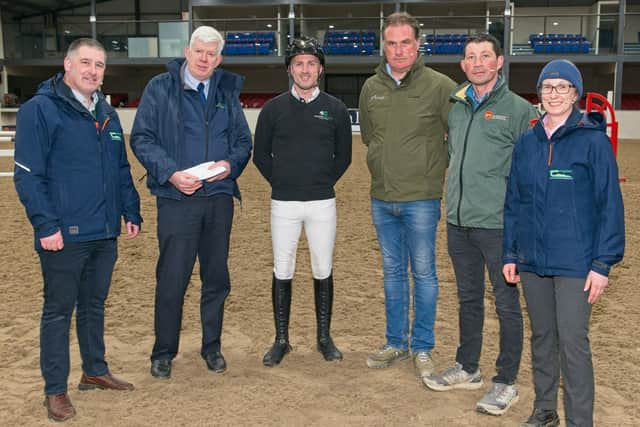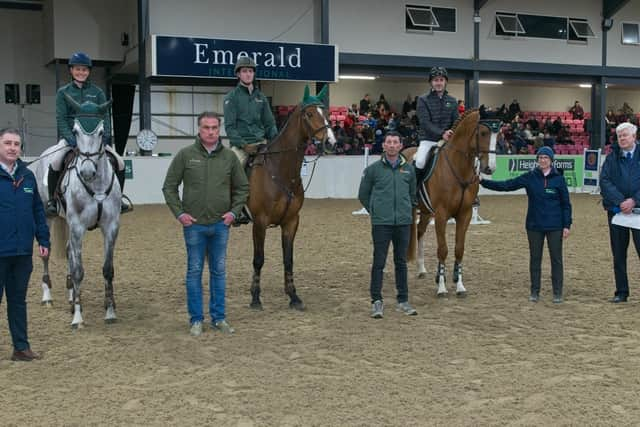Equine demonstration event at Emerald Equestrian Centre, Co Kildare
and live on Freeview channel 276
A large crowd of almost 150 breeders, producers and other equine enthusiasts joined an evening of equine demonstration and discussion at Emerald Equestrian Centre facilitated by equine specialists Wendy Conlon, and Seán Keane.
Six quality horses were showcased by the Equitation School, Cooley Farm and Lissyegan stables, in two groups of three with one from each farm in both groups.
Advertisement
Advertisement
This provided a unique opportunity to compare the models, way of going and discuss the early production for both the sport of show jumping and eventing.


The demonstration and discussion focused on assessing the horses in the context of desirable traits, while acknowledging weaknesses that demand adaptation in training.
The horses were presented under saddle on the flat and over a small course of fences and then stripped of tack to view “in the hand”, placing the traits of conformation and athleticism under the microscope.
Richard Sheane was clear in his view that “the event horse and jumping horse types are aligning, with the jumping horse becoming more and more blood and the event horse needing to be more balanced to meet the demands of both dressage and show jumping”.
Advertisement
Advertisement
Commandant Geoff Curran added: “If you are jumping three days in a row, it is the extra blood that makes the last day easier. ‘Old-fashioned’ horses without enough blood cannot win in today’s competition arenas”.


The blood referred to is lightness in the paces, quick reflexes and reactions, and blood (quality) in the model rather than necessarily indicating thoroughbred blood as is often interpreted.
Damien Griffin spoke of the difference in way of going and approach to a fence describing the “event horse is quicker to and over the fence compared to the showjumper”.
Richard Sheane endorsed: “The eventer can be quicker across the fence which the showjumping guys won’t like as much, but ‘she’ is careful too, and the pace is needed across country.”
Advertisement
Advertisement
Commandant Curran spoke of differences in scope noting: “A horse with blood can improve their scope with the right work, though not always a given.”
All panellists agreed that temperament and rideability is paramount. He also referenced “buying a horse with a good brain, that is trainable, goes a long way to success”.
On the topic of production Damien explained he “used to let the owners dictate the programme of training, now he explains to owners what he needs to do in the best interest of the horses and sometimes that means less competition”.
All three presenters placed significant emphasis on the importance of the rider ability when working with young horses.
Advertisement
Advertisement
Richard Sheane emphasised the horses “need to be educated correctly. Regardless of talent a horse must be riding well, particularly for US clients”.
Damien supported this adding “if they aren’t pretty they have to ride well, and perform to be able to sell”.
With regard to the question of supply versus demand. Richard commented that “the standard of young horses available has improved immensely”, however for his professional clients demands he cannot find enough horses here and is sourcing horses also in France as they have a similar rearing system.
Damien expressed it is “hard to find enough of the good ones”.
Advertisement
Advertisement
Commandant Curran emphasised that people should “take care in selecting the horses to put investment and effort into, otherwise your heart will be broken”.
Knowing when to sell is also important as holding on to the horses on false hopes of potential for too long can become costly.
Wendy Conlon thanked the presenters on behalf of the equine specialist team with special thanks and appreciation to Commandant Geoff Curran, Damien Griffin and Richard Sheane, three highly regarded industry professionals, for their commitment to sharing their knowledge and experience.
She said: “It was the quality of the horses that “stole the show” and clearly demonstrated the demands of the sports.
Advertisement
Advertisement
“All panellists concurred on the need to place the welfare and development of the horse at the centre of decision making, and in choosing the production pathway and training priorities, rather than simply conforming to the expected norms or benchmarking specifically to the timelines of the industry age classes.”
The Teagasc specialist thanked riders Lieutenant Michael Byrne and Second Lieutenant Raphael Lee, and Amanda Goldsbury, grounds persons Private Elena Sheehy, Corporal Barry Keogh, Fiona Griffin, and Ciara O’Connor; Dervan Sound, local Teagasc staff David Colbourne, Caroline Dardis, Martha Charles, Peter Doolan, Margaret Farrell, Francis Kennedy, rural development team administrator Vanessa Keane and all at Emerald Equestrian Centre.